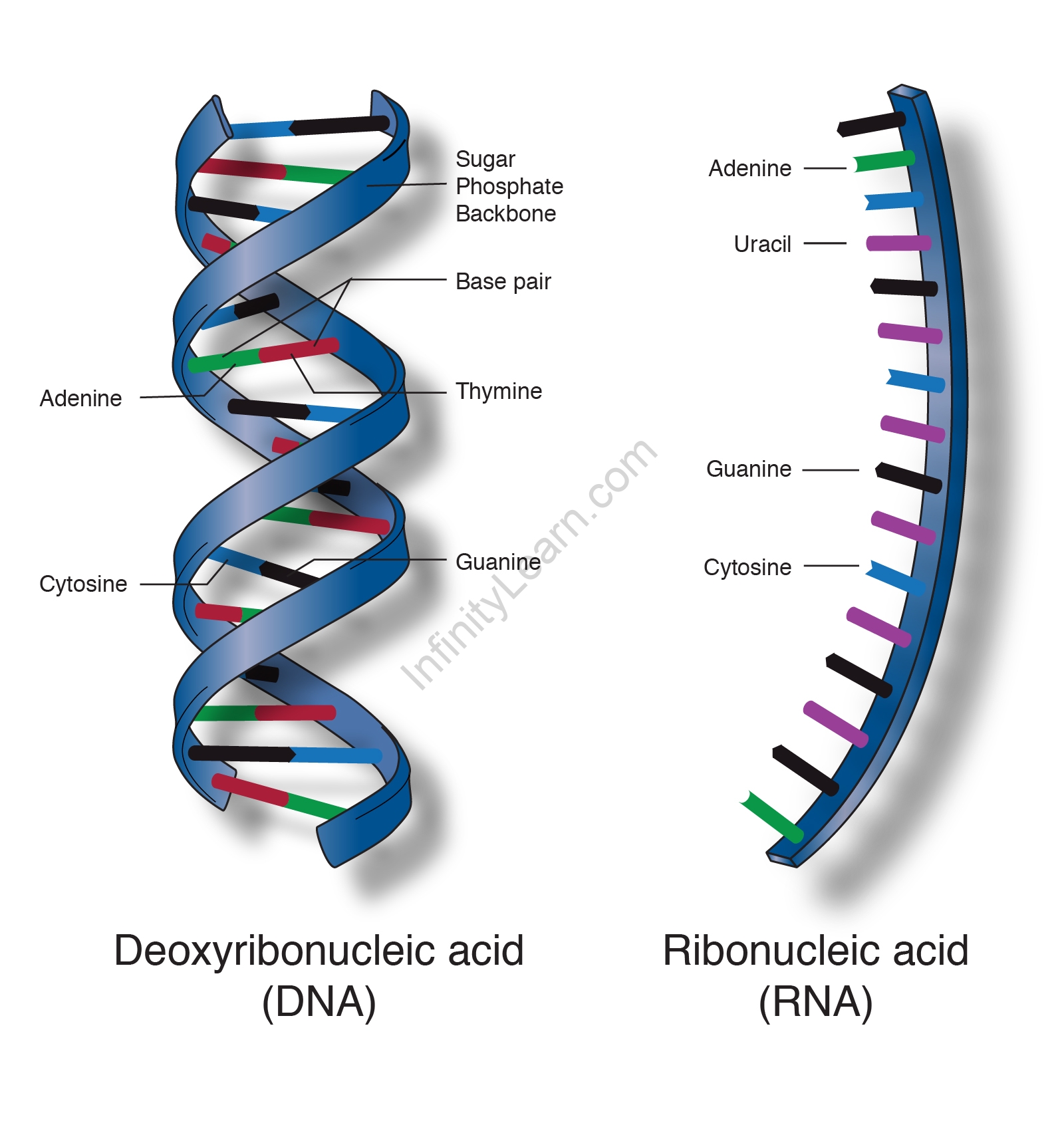Table of Contents
Nucleic acids are long-chained polymeric molecules. The monomer or repeating unit is known as a nucleotide, and thus nucleic acids are sometimes referred to as polynucleotides. Organic molecules found in living cells are known as nucleic acids. It is crucial in the transmission of genetic information from one generation to the next. Nucleic acids are polymers of nucleotides made up of DNA and RNA. Phosphoric acid, sugars, and an organic base combination can be made from nucleic acid, which is a naturally occurring chemical molecule (purines and pyrimidines). Nucleic acids are the primary information-carrying molecules in the cell, and they determine the inherited characteristics of all living things by directing the process of protein synthesis. Nucleotide monomers are linked together in the nucleus and consist of distinct components such as a Phosphate Group, Nitrogenous Bases or Ribose and Deoxyribose. Nitrogenous bases are classified into two types: pyrimidines and purines. Cytosine and thymine are the building blocks of pyrimidines. Guanine and adenine are the building blocks of purines. In ribonucleic acid, thymine is replaced by uracil, whereas deoxyribonucleic acid contains all four bases.
Types of nucleic acid
The two main types of nucleic acids are DNA and RNA. DNA (deoxyribonucleic acid) is the master blueprint for life, and it can be found in all free-living organisms as well as the vast majority of viruses. RNA (ribonucleic acid) is the genetic material of certain viruses, but it is also found in all living cells, where it is important in processes such as protein synthesis. Nucleic acid is a type of macromolecule that is found in all cells and viruses.
Nucleic acid functions include genetic information storage and expression. The information required by the cell to produce proteins is encoded by deoxyribonucleic acid (DNA). Ribonucleic acid (RNA), a related type of nucleic acid, exists in various molecular forms and is involved in protein synthesis.

Deoxyribonucleic Acid (DNA)
DNA is made up of instructions that monitor the operation of all cell functions. It is a cellular molecule with chromosomes. They are found in the nucleus of cells and are responsible for cellular activity. It is a twisted double helix formed by two polynucleotide chains. DNA has two strands that run parallel to each other. Two helices are joined by a hydrogen bond, and the bases are bundled within the helix. Because of the presence of phosphate groups, DNA is negatively charged. DNA is made up of pentose sugar, phosphoric acid, and some nitrogen-containing cyclic bases. -D-2-deoxyribose is the sugar moiety found in DNA molecules. Adenine (A), guanine (G), cytosine (C), and thymine are nitrogen-containing cyclic bases (T). These bases, as well as their arrangement in DNA molecules, play an important role in the transmission of information from one generation to the next.
Deoxyribonucleic acid (DNA) is a nucleic acid that contains the genetic instructions that all known living organisms use in their development and function. The genetic information is carried by genes, which are DNA segments. Similarly, other DNA sequences serve structural functions or play a role in regulating the use of this genetic information. DNA, along with RNA and proteins, is one of three major macromolecules required for all known forms of life. DNA is made up of two long polymers of simple units called nucleotides that have backbones made of sugars and phosphate groups linked together by ester bonds. These two strands are anti-parallel because they run in opposite directions. Each sugar has one of four types of molecules known as nucleobases attached to it (informally, bases).
Ribonucleic Acid (RNA)
The RNA molecule is also made up of phosphoric acid, a pentose sugar, and some nitrogen-containing cyclic bases. The sugar moiety in RNA is -D-ribose. Adenine (A), guanine (G), cytosine (C), and uracil are the heterocyclic bases found in RNA (U). The fourth base in RNA differs from the fourth base in DNA. RNA is typically made up of a single strand that folds back on itself to form a double helix structure. There are three kinds of RNA molecules, each with a distinct function:
- messenger RNA (m-RNA)
- ribosomal RNA (r-RNA)
- transfer RNA (t-RNA)
RNA is essential in the synthesis of proteins, which primarily involves the decoding and translation of genetic code, as well as transcription to produce proteins.
Ribonucleic acid (RNA) is responsible for converting genetic information from genes into protein amino acid sequences. Transfer RNA (tRNA), messenger RNA (mRNA), and ribosomal RNA are the three universal types of RNA (rRNA). Messenger RNA is responsible for transporting genetic sequence information between DNA and ribosomes, directing protein synthesis, and carrying instructions from the nucleus to the ribosome. Ribosomal RNA reads the DNA sequence and catalyses the formation of peptide bonds. Transfer RNA is responsible for decoding the mRNA as well as acting as a carrier molecule for amino acids used in protein synthesis. Furthermore, many other types of RNA are now known.
FAQs
What are the differences between the nucleic acids DNA and RNA?
DNA and RNA differ in two ways: (a) RNA contains the sugar ribose, whereas DNA contains the slightly different sugar deoxyribose (a type of ribose that lacks one oxygen atom), and (b) RNA contains the nucleobase uracil, whereas DNA contains thymine.
What are the types of nucleic acids?
Deoxyribonucleic acid (DNA) and ribonucleic acid (RNA) are the two main types of nucleic acids (RNA). DNA is the genetic material found in all living organisms, from bacteria to multicellular mammals.
Infinity Learn App
Now you can find answers to all your subject queries & prepare for your Exams on our Educational App – Infinity Learn.



